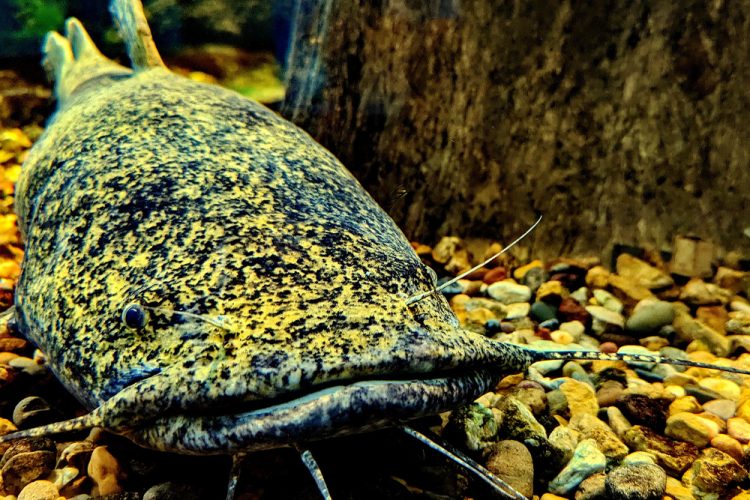Flathead catfish: more muscle, more mystery. This underwater brute isn’t like your average blue or channel cat. Read how to hook your first flathead the right way in our latest Catfish Basics column. (Photo by Keith Sutton)
Understanding Flatheads
By Keith “Catfish” Sutton
Flathead catfish are a different breed—literally and behaviorally. They don’t look like blues or channels, they don’t act like them, and if you fish for them the same way, you’ll likely strike out.
Want to catch more flatheads? Start by understanding what makes them tick. Here’s a breakdown for beginner anglers looking to target these heavyweight predators.
Flatheads Look—and Act—Different
Flatheads have a broad, flat head (hence the name), a protruding lower jaw and skin that ranges from brown to yellow with dark mottling. Even beginners can usually ID one on sight.
But their behavior is what really sets them apart. Where blues and channels often roam and feed in schools, flatheads are solitary, territorial and picky about what they eat and where they live.
Go Live or Go Home
Flatheads eat other fish, and they prefer their meals alive and kicking. Smaller flatheads (under 2 feet) often eat crayfish, worms and stinkbaits. Big flatheads, on the other hand, (the kind most anglers want) almost always go after live fish, especially sunfish, shad, suckers, chubs and even small catfish like bullheads.
You might get lucky with cut-bait, but if you want to be consistent, live bait is the gold standard. A frisky baitfish darting around in the water is exactly what flatheads are looking for. Fall back on cut-baits only when live baits aren’t available.
Don’t Waste Time in Winter
Flatheads don’t like the cold. Once water temps fall below about 45°F, they go into a kind of hibernation called torpor. They’ll hole up in deep cover and may not feed for weeks.
Skip the dead of winter. The best times to target flatheads are:
- Spring, when they’re active in rising water
- Summer, especially before and after the spawn
- Fall, when they fatten up for winter
When they’re moving, they’re eating. When they’re cold, they’re ghosts.
Big Water, Big Fish
Flatheads aren’t pond fish. They thrive in:
- Large rivers
- Deep reservoirs
- Big natural lakes with good structure
In rivers, they avoid strong current and prefer slower water like eddies, slackwater pools or behind wing dikes. But they’ll move into heavier flow to feed, especially near dam tailraces and dike ends.
In lakes and reservoirs, look for deep holes with wood cover, drop-offs or submerged creek channels. Flatheads love to hang in places where they can hide and ambush prey.
Cover Is King
Flatheads are ambush predators. By day, they tuck deep into cover like:
- Brush piles
- Root balls
- Fallen timber
- Under rocks or ledges
They’ll wedge themselves in, face-out, and wait for something edible to swim by. That’s why you’ll need to get your bait into the junk, not just near it.
Use a slip-float rig and a long rod (7–9 feet) to drop a live baitfish into the thick stuff without getting tangled. Steer your bait into the strike zone.
Nighttime is Prime Time
At night, flatheads leave their hiding spots and go on the hunt. They move into:
- Shallow flats
- Creek mouths
- Edges of channels and humps
They’re still structure-oriented, but they cover more ground. This is when you can fish with a bottom rig in open water, near drop-offs or brush piles, and expect bites.
Keep your bait alive and active. A baitfish flailing on a hook is like a dinner bell ringing for a hungry flathead.
One Fish, One Spot
Unlike channel cats or blues, flatheads aren’t group feeders. If you catch one, that might be the only one using that cover. Flatheads don’t like roommates.
They also don’t move much. Studies show most adult flatheads stay within about a mile of their chosen home all year long.
So, here’s the deal:
- Fishing one spot all night? You might catch one fish.
- Using a boat to cover water, hitting several brushy holes or deep bends? That gives you a shot at catching multiple fish in a single trip.
Bank anglers can catch flatheads, too, but need to be patient and pick high-percentage spots.
Final Tip: Don’t Fish for Flatheads Like They’re Channel Cats
Too many anglers use the same gear, bait and tactics for all three major catfish species. That’s a mistake. Flatheads demand a different approach.
To catch them, you need to:
- Use live bait
- Target thick cover
- Fish at night or during active feeding times
- Be mobile if you’re in a boat
- Be patient if you’re on the bank
The more you learn about flatheads, the more success you’ll have. It’s not easy, but that first big flathead will make every snag, tangle and lost baitfish worth it.



